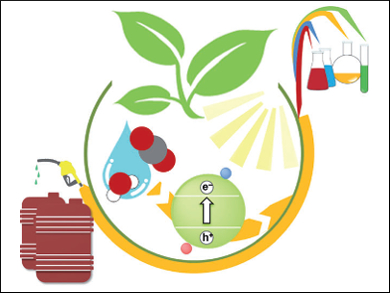Artificial photosynthesis uses sunlight to create high-value chemicals from abundant resources. It is seen as the most promising method for sustainable fuel and chemical production.
Peidong Yang and colleagues, University of California, Berkeley, CA, USA, have summarized the state-of-the art and challenges of artificial photosynthesis by looking at its main research areas: photoelectrochemical water splitting, electrochemical carbon dioxide reduction, and the production of fuels and chemicals from renewable hydrogen. Recent research has led to efficient light-absorbing semiconductors with high photoelectrochemical output and efficient catalysts to convert raw materials into a diverse range of products. These achievements make it clear that artificial photosynthesis is possible, but there are challenges to overcome:
- Splitting water into H2 and O2 involves integrated systems for light harvesting and catalytic conversion. The stability and performance of the photoanode material has to be improved.
- Optimized catalysts are needed for the conversion of CO2 to products like CO, methane, or ethylene. It is challenging to find the right transition metal catalyst for each desired reaction, balancing activity, selectivity, and stability. Approaches to optimize the catalysts include nanostructuring and using bimetallic catalysts like Au–Cu systems.
- For the catalytic conversion of renewable H2 to various species, it is crucial to efficiently couple the photosynthetic device with other fields in catalysis.
- Artificial Photosynthesis for Sustainable Fuel and Chemical Production,
Dohyung Kim, Kelsey K. Sakimoto, Dachao Hong, Peidong Yang,
Angew. Chem. Int. Ed. 2015.
DOI: 10.1002/anie.201409116
BASF celebrates its 150th anniversary this year. As part of the celebrations, Angewandte Chemie publishes a special jubilee issue where this article is included.
Other articles include
- We Create Chemistry for a Sustainable Future,
ChemViews Mag. February 15, 2015.
Commemorating the 150th anniversary of BASF, highlights from the company’s history are given as well as a vision for the futur
Also related to the anniversary
- Prototype of Magnetocaloric Wine Cooler,
Veronika Belusa,
ChemistryViews.org January 13, 2015.
Energy-efficient refrigeration systems operate with less noise and use water-based coolants instead of gaseous refrigerants - Magnetocaloric Refrigeration: Reinventing the Fridge?,
Ekkes Brück, Delft University of Technology, The Netherlands
February 13, 2015.
Will magnetocaloric materials make refrigeration technology more efficient and sustainable? - More articles related to the 150th anniversary of BASF




